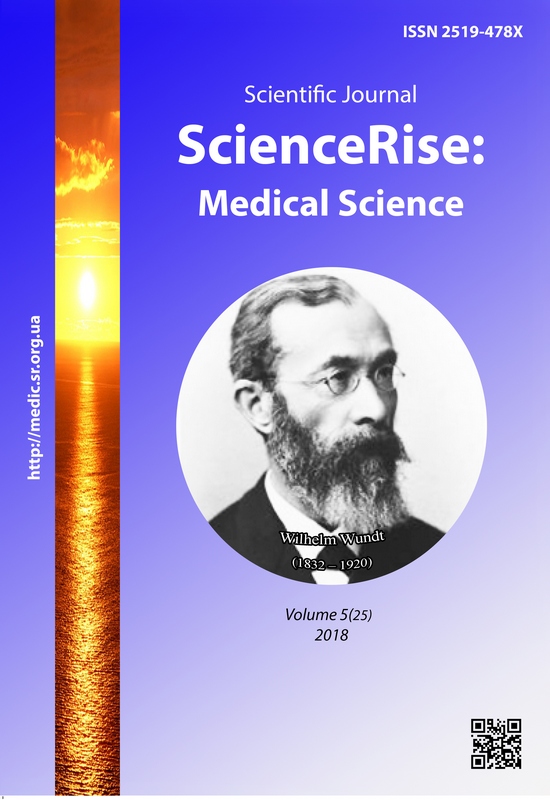Psychohygienic characteristics of the prenosological psychodiagnostics of pupils with vision pathology
DOI:
https://doi.org/10.15587/2519-4798.2018.139784Keywords:
visual impairment, psychodiagnostics, prenosological state, mechanical memory, disadaptation, psychohygiene, psychoprophylaxisAbstract
The aim. The article represents the results of the study of criterial psychophysiological functions of adolescents with visual impairment. The interconnections of the visual analyzer with other analyzers and central nervous system, their participation in creating of visual-spatial representations, as well as the importance of the influence of adaptive factors on the development of the organism of such adolescents to the environment and, above all, to the educational process. These adolescents have a high risk for the development of the maladaptation states. That is why the purpose of the study was to solve one of the modern problems of preventive medicine - the problems of health promotion and adaptation to the environment of such adolescents, because they require special measures for social and professional adaptation in connection with the health features. In addition, to establish the criterion role of the function of short-term memory in the psychodiagnosis of functional state and prediction of adaptive abilities of adolescents with pathology of the organ of vision.
Materials and methods. Based on the objectives of our research were used universally adapted methods: "psycho diagnostic questionnaire of the high school student", based on an assessment of the functional state of the central nervous system, its criterion physiological functions and assessment of the mechanical memory volume by the method of "complete reproduction of numerical series" with the expectation indicator - the amount of short-term memory (STM).
Results. Consequently, the results of the study on the psychophysiological state of the students of all the studied groups indicate the influence of a complex of external factors, primarily related to the school environment. After all, the learning process is accompanied by stressful loads that create conditions for the active manifestation of latent disease processes. The results of such influence are reflected in the success of certain activities, including the training process and the peculiarities of pupils' behavior.
Conclusions. In order to optimize the process of psychohygienic psychophysiological adaptation of students with visual impairments, it is proposed: improving the mental condition, correction of emotional-volitional and cognitive areas receiving help in socialization. The educational process must be carried out taking into account the peculiarities of mental and physical development in terms of the content, forms and methods of teaching, the corresponding regime of the day, which ensures the system of teaching and educational, medical and preventive work, rehabilitation measures. In general, the educational process in these institutions should have a vector for correction and development of the adolescent
References
- Kolupayeva, A. A., Savchuk, L. O. (2011). Children with special educational needs and organization of their education. Kyiv: Publishing group "ATOPOL", 274.
- Bilyk, Y. V. (2015). Features of the life of children with visual impairment. Scientific Bulletin of Uzhgorod National University, 35, 32–34.
- Lubovsky, V. I. (Ed.) (2006). Special Psychology. Moscow: Academy, 464.
- Withagen, A., Kappers, A. M. L., Vervloed, M. P. J., Knoors, H., Verhoeven, L. (2012). Haptic object matching by blind and sighted adults and children. Acta Psychologica, 139 (2), 261–271. doi: http://doi.org/10.1016/j.actpsy.2011.11.012
- Korobchansky, V. O. (2005). Hygienic psychodiagnostics of pre-natal states in adolescence and adolescence. Kharkiv: Contrast, 192.
- Korobchansky, V. O., Padalalenko, O. V., Vasilchenko, I. O., Vitrischak, S. V. (2005). Psycho-diagnostic questionnaire for senior pupils as a method of assessing the pre-psychological mental status of adolescents. Kyiv, 4.
- Wan, C. Y., Wood, A. G., Reutens, D. C., Wilson, S. J. (2010). Early but not late-blindness leads to enhanced auditory perception. Neuropsychologia, 48 (1), 344–348. doi: http://doi.org/10.1016/j.neuropsychologia.2009.08.016
- Gagnon, L., Ismaili, A. R. A., Ptito, M., Kupers, R. (2015). Superior Orthonasal but Not Retronasal Olfactory Skills in Congenital Blindness. PLOS ONE, 10 (3), e0122567. doi: http://doi.org/10.1371/journal.pone.0122567
- Korobchansky, V. O. (2015). Hygienic estimation and optimization of functional state of students of higher medical educational institutions on the basis of introduction of principles of medicine of boundary states. Experimental and clinical medicine, 3 (68), 154–158.
- Guducu, C., Oniz, A., Ikiz, A. O., Ozgoren, M. (2015). Chemosensory Function in Congenitally Blind or Deaf Teenagers. Chemosensory Perception, 9 (1), 8–13. doi: http://doi.org/10.1007/s12078-015-9199-2
- Ward, J., Meijer, P. (2010). Visual experiences in the blind induced by an auditory sensory substitution device. Consciousness and Cognition, 19 (1), 492–500. doi: http://doi.org/10.1016/j.concog.2009.10.006
- Pasqualotto, A., Proulx, M. J. (2012). The role of visual experience for the neural basis of spatial cognition. Neuroscience & Biobehavioral Reviews, 36 (4), 1179–1187. doi: http://doi.org/10.1016/j.neubiorev.2012.01.008
- Deen, B., Saxe, R., Bedny, M. (2015). Occipital Cortex of Blind Individuals Is Functionally Coupled with Executive Control Areas of Frontal Cortex. Journal of Cognitive Neuroscience, 27 (8), 1633–1647. doi: http://doi.org/10.1162/jocn_a_00807
Downloads
Published
How to Cite
Issue
Section
License
Copyright (c) 2018 Olga Sasina, Vladimir Korobchanskiy

This work is licensed under a Creative Commons Attribution 4.0 International License.
Our journal abides by the Creative Commons CC BY copyright rights and permissions for open access journals.
Authors, who are published in this journal, agree to the following conditions:
1. The authors reserve the right to authorship of the work and pass the first publication right of this work to the journal under the terms of a Creative Commons CC BY, which allows others to freely distribute the published research with the obligatory reference to the authors of the original work and the first publication of the work in this journal.
2. The authors have the right to conclude separate supplement agreements that relate to non-exclusive work distribution in the form in which it has been published by the journal (for example, to upload the work to the online storage of the journal or publish it as part of a monograph), provided that the reference to the first publication of the work in this journal is included.









